4 of North Carolina’s Oddest Pollinators (They Aren’t Bees)
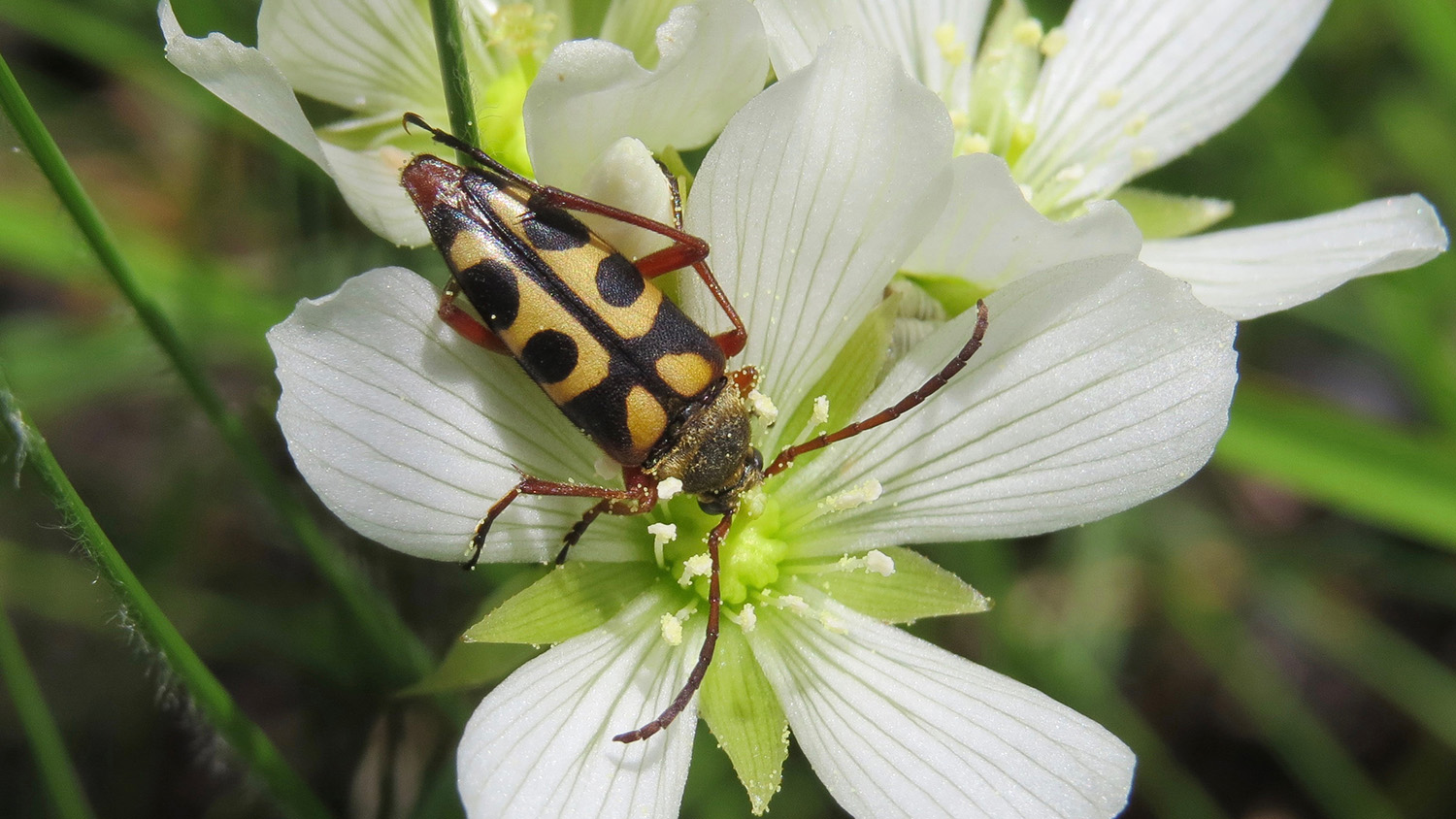
Editor’s Note: This is a guest post by Elsa Youngsteadt, an entomology research associate at NC State. This post is part of our NC Knowledge List series, which taps into NC State’s expertise on all things North Carolina.
With all the fuss about bee health and pollinator protection in the news over the past few years, it’s easy to slip up and start using the word “pollinator” interchangeably with the word “bee.” It’s true that bees—including more than 500 species in North Carolina—are, collectively, important pollinators. But they’re not the only animals capable of moving pollen from flower to flower.
Indeed, globally, non-bee insects complement the activity of bees and contribute nearly as much to crop pollination as bees do. But some plants depend especially on non-bees, and North Carolina has its own menagerie of oddball pollinators and the plants that require them—or at least benefit from them. Here are four.
1. Ants (Piedmont granite outcrops)
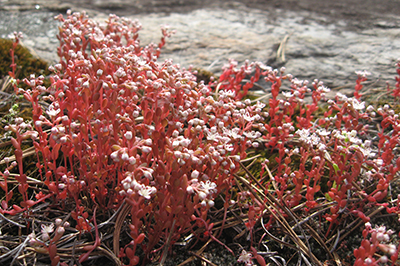
Ants are usually awful pollinators. To put ants in perspective, think of all the things that make bees great at this job: bees collect pollen on purpose, so they actually want it on their bodies—which are fuzzy, and therefore hold onto a lot of it. They fly, so they move from flower to flower over distances of a city block or more. As a result, they move large amounts of pollen over long distances.
Ants do none of those things. They’re little, smooth, and fastidious—and workers of many species don’t travel more than a few meters from the nest in their lifetime. To make matters worse, most ants are slathered in pollen-killing chemicals. They secrete antimicrobial compounds, which help prevent outbreaks of bacteria and fungi in their colonies, but also kill pollen.
Nevertheless, there are a few plants that have managed to make ant pollination work. One of the few documented examples comes from right here in North Carolina: the diminutive plant known as elf-orpine (Diamorpha smallii). Growing only an inch or two tall, the plant lives on granite and sandstone outcrops from Tennessee to Alabama. Research in the late 1970s showed that, because the plants are so little, ants can visit 20 or 30 of them in just five minutes, while traveling less than a meter. The pollen is clumpy, and manages to hold onto the ants for the journey between flowers. The ants in question are just slightly-hairier-than-average red ants, Formica schaufussi. For most plants, this would never work, but for the miniature elf-orpine, an ant out for a few meter’s journey to collect nectar is just the ticket.
2. Beetles (Coastal pine savannas)
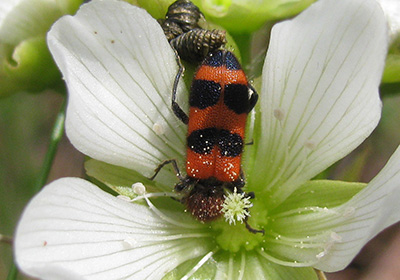
They may not fit the busy-bee mold, but beetles can be especially good at moving pollen over long distances. Then again, any sentence that includes the words “beetles can” may not be worth much, given that beetles account for a quarter of all the described species on the planet. So let’s just cut straight to an interesting Carolinian case study: the beetles that visit Venus flytrap flowers.
Over the past few years, I’ve been lucky enough to be involved in research that documents, for the first time, the pollinator community of this fantastic carnivorous plant. Although it’s grown in greenhouses worldwide, Venus flytrap is native only to the wet pine savannas of coastal North and South Carolina. In May and June, it opens cheerful white flowers atop a tall stem six to ten inches above its deadly, insect-eating traps.
Those flowers, it turns out, are visited by more than 100 kinds of insects and spiders—but the ones that are the most consistent visitors, and carry the most pollen, include a green sweat bee and two kinds of beetles: a flower longhorn beetle (Typocerus sinuatus) and a checkered beetle (Trichodes apivorus). The beetles are there to munch on the pollen, but they get plenty of it on their bodies, where it can be carried to the next flower.
None of these three characters end up in the traps, which capture primarily spiders and ants. Research is ongoing at NC State to find out just how effective these beetles are as pollinators, as well as to understand how flytrap flowers and traps attract such different kinds of bugs.
3. Butterfly wings (Mountain forests and balds)
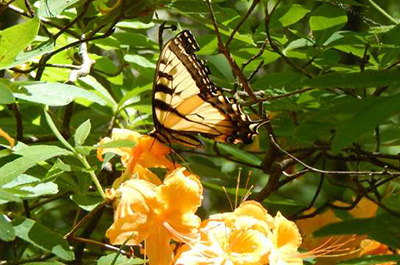
Butterflies tend to stand on flowers with tall, stilty legs, and sip nectar with a long, straw-like mouth. Keeping a flower at arm’s length, as butterflies do, results in little contact with pollen, and these insects are rather poor pollinators of most flowers. But head out to the mountains of western North Carolina in June and you’ll see a striking exception: flame azalea.
The flared, orange flowers have long, elegant pistils and stamens that arch out in front of the petals—putting both the pollen and the pollen-receiving structures (stigmas) at arm’s length from the rest of the flower. Here, bees are useless. They do show up, but never touch both the pollen and the stigmas, as required.
Instead, it’s butterflies that get the job done. Tiger swallowtails (Papilio glaucus) flap their wings as they sip the nectar, brushing them against both the pollen and the stigmas and transferring the pollen.
4. Flies? (Woodlands)
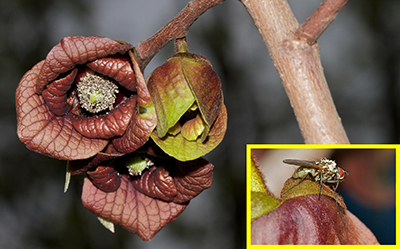
Flies can definitely pollinate. For a world-famous example, consider the planet’s largest flowers (in the Southeast Asian genus Rafflesia), which attract filth flies by producing warmth and fetid rotten-meat odor. Not that flowers have to be stinky to attract flies—other kinds of flies, such as hover flies, regularly visit normal, sweet flowers for pollen and nectar. But flowers that use fungus gnats and filth flies are often brown and smelly.
Which brings us to our own, native pawpaw tree (Asimina triloba)—a temperate holdout in the otherwise tropical plant family Annonaceae. Pawpaws grow throughout eastern North America, from Ontario southward, particularly in lowland forests. In early spring, they open deep maroon, six-petaled flowers, about the diameter of a quarter or a nickel, which produce an unusual, yeasty aroma. A study published in 1980 confirmed that the flowers almost always need cross-pollination to set fruit. The internet (and my backyard) offer many instances of flies, both large and small, landing on pawpaw flowers, suggesting that the brown color and fermenty odor are attracting these insects as pollinators. Indeed, some pawpaw growers have hung carrion in their trees to attract more flies!
And yet the actual pollinators of pawpaw are, as best I can tell, not really documented. The closest example is from a couple of other species of Asimina in Florida, which have similar flowers and are indeed well pollinated by beetles and flies. Someday, perhaps we’ll know who really pollinates the largest edible fruit native to North America!
- Categories:


